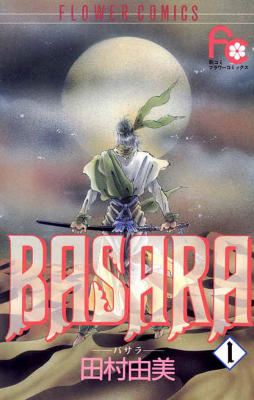
User rating of this review - 4.5 out of 5
Story/Plot - 5 out of 5
Characters - 4.5 out of 5
Drawing Style - 4 out of 5
Enjoyment - 5 out of 5
Overall - 4.75 out of 5
Plot/Story
Although it's hard to tell at first, Basara is a post-apocalyptic science fiction story, set in the future. The technology of Japan (and other nations) has been set back. Under the tyrannical rule of the Emperor and his children, the four Kings, the people of Japan suffer. It is into this time that Tatara, the prophesied "child of destiny", is born in a small desert village. However, the legend begins when he is hunted down and brutally executed in front of his people. In her grief, Sarasa, his twin sister, cuts off her braids, casting aside her femininity and rising up in front of her people to call herself the true Tatara, the child of destiny.
Sarasa's mission is at first simple: avenge her family by killing the Red King, the one who ordered her brother killed. As the story progresses, she gains new allies and new goals. As the champion of the oppressed and enslaved, "Tatara" vows to liberate Japan and make its people equal by first uniting the four swords of rebellion: Byakko, Suzaku, Seiryū and Genbu. In her wake and on her path lie blood and tears, death and suffering.
Yet underneath the strong-willed Tatara's mask is a ordinary girl. Sarasa also discovers her own conflicting desire for happiness. She falls in love with Shuri, a handsome man who loves her in return. They meet only by coincidence and part not knowing when they will next meet... and the secret that neither knows is that their lover is also their nemesis, the one that they must kill in order to achieve their goals...
Each character brings different strengths and weaknesses to the story, contributing to a complexly narrated and brilliantly conceived future of a Japan struggling to be free. Aside from being a tale of love, adventure, and tragedy, Basara is also a moral tale: the cost and toll of war is never forgotten. Despite this, there is also hope for the future - Tatara is bringing change to all of Japan.
Characters
This story ties together characters of different backgrounds, personalities, and motives. The two main characters are both lovers and antagonists: Sarasa, the "child of destiny" who will change Japan, and Shuri, the Red King, who seeks to defeat Tatara and unite Japan under his rule. Each character is endowed with weaknesses and strengths that serve to compliment each other and further the story. Although Sarasa is primarily a determined and strong-willed person, she also becomes angry, faces despair, and makes rash decisions. Although Shuri is always arrogant and proud, he gradully becomes capable of friendship and kindness.
The character relationships are complex and create much of the underlying tension; Basara is a very character-driven story. Other characters who figure into the destiny of the future Japan include Ageha, the elusive and enigmatic survivor of a lost nomadic tribe, Nagi, the prophet who predicted the "child of destiny", Asagi, the Blue King, who plots vengeance on Shuri, and many others - including and not limited to a pirate captain, a noble woman, a journalist, and two martial artists from the independent, democractic island of Okinawa. Character development and change continues to happen throughout the story. The characters' emotions and actions ultimately change the future, for better or for worse. Each person faces self-doubt and grows after each emotional battle. It's refreshing to see characters who need help and must rely on each other, instead of simply picking themselves up and recovering quickly from every emotional wound.
Drawing Style
I wouldn't say that Basara has anything special to its art -- it's very typical 90's manga art -- but it certainly fits the story. The actions scenes flow together very well without confusion, the characters, though numerous, rarely look alike (unless it's important to the plot), and surprisingly, unlike other series (such as Hana Yori Dango and Fruits Basket) the character designs don't appear to change very much in the course of 20+ volumes. The eyes show particular expressiveness and the gender ambiguity of more than one character is pulled off very well. Therefore, I would say this series is very well-illustrated and I wouldn't change anything about the art.
Enjoyment
The story is fascinating and the volumes are hard to put down. The action is intense (and tense), the romance heart-breaking, the politics both realistic and complex (yet not so much as to bog down the story). There isn't much laugh-out-loud comedy, although there are silly moments, which seems appropriate for a mostly serious story. There are tragic elements and bittersweet moments mixed into , making this series a good balance between typical shallow shoujo-series violence and hardcore shounen action. Overall, the story is a very enjoyable cross-genre series that should appeal to anyone. It's one of those series that you don't want to put down once you pick it up, so be warned.
Overall
Unlike many other series, characters, events, places and objects from the first volume continue to be important and affect events much later on. The plot is continuous and flows from one event to the next, so much that it's hard to tell how much time is passing. The story is well-constructed and each chapter builds upon the next. Each element of the story is solid and the story, though long, is always interesting. It's difficult to give this series a perfect rating, however, since I haven't read the ending yet, although I'm looking forward to it; still, I highly recommend this series.
An excellent review.
I haven't read the series myself, but reading your detailed descriptions made me want to pick this up... You warned that this will be addicting, so I will do so when I have more time to read.
... Last updated 17 years ago





